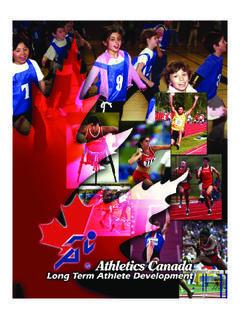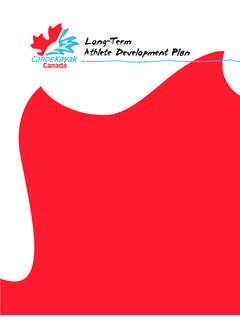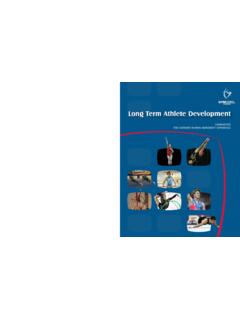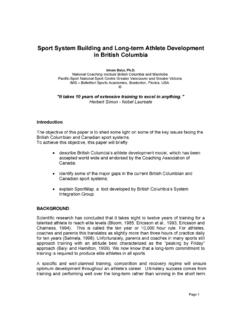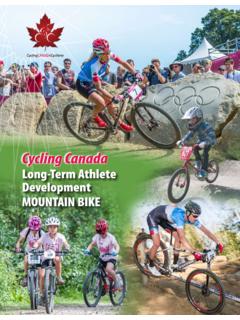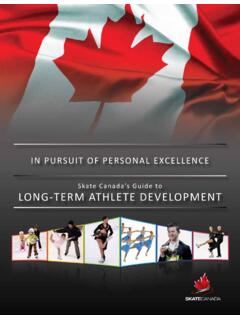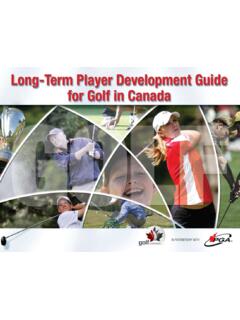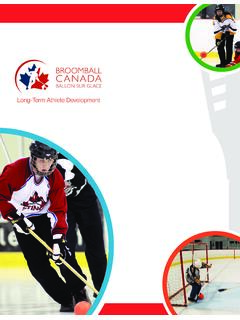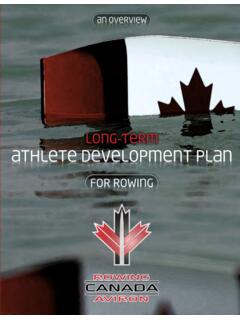Transcription of Table of Contents - Athletics Canada
1 Table of ContentsIntroduction .. 1 Why we need a long Term Athlete development Model .. 3 The long Term Athlete development Framework ..4 Trainability - Applying the long Term Athlete development Model .. 5 The 9 Stages of long Term Athlete development Stage 1: Active Start Stage .. 7 Stage 2 Fundamental Stage (Fundamentals 1) ..8 Stage 3: Learning to Train Stage (Fundamentals 2) ..9 Stage 4: Training to Train Stage ( Building the Engine ) .. 10 Stage 5: Learning to Compete ( Challenge of Competition ) .11 Stage 6: Training to Compete ( Heat of the Battle ) .. 12 Stage 7: Learning to Win ( Consistent Performance ) .. 13 Stage 8: Winning for a Living ( Performing when it Counts ) 14 Stage 9: Active for Life ( Dealing with Adversity ).
2 15 16 Glossary of terms .. 17 Appendix: Athletics Canada Charts Optimal Trainability .. 20 long -Term Athlete development -Periodization .. 21 Acknowledgements .. 22 Cover Page:Children from Bayview Public School: Jasmine Masse, Geoffrey Jackson, Natasha Wills-Ibarra, Chloe Hutchison, Chelsea Thompson, Andrew GudgeonPhoto by: Grey Mortimore Chantal Petitclerc100m, 200m, 400m, 800m, 1500m (T54)Photo by: Peter ThompsonJessica MassicotteShot Put Photo by: Grey MortimoreAndrew ChingTriple JumpPhoto by: Pat RileySara JordanLong JumpPhoto by: Pat RileyDustin Walsh and Blair Miller (Guide)200m, 400m (T11)Photo by: Peter ThompsonAndy MillerPole VaultPhoto by: Peter ThompsonPerdita Felicien100 m HurdlesPhoto by: Grey MortimorePage 2:Tyler Christopher400mPhoto by: Claus AndersenDavid Pedneault100m, 200mPhoto by: Grey MortimorePhilip Robson400mPhoto by: Pat RileyPage 3.
3 Andrea Holmes (F44)100m, 200m, long JumpPhoto by: Peter ThompsonPage 5:Tenesia Peart100mPhoto by: Grey MortimoreKyle HelfShot PutPhoto by: Grey MortimoreDavid Pedneault100m, 200mPhoto by: Grey MortimoreMarc-Andr CastonguayJavelin Photo by: Pat RileyGenevi ve Thibault100m, 200mPhoto by: Christian LandryPage 10:Marc-Andr CastonguayJavelin Photo by: Pat RileyPage 11:Andrew ChingTriple JumpPhoto by: Pat RileyPhoto CreditsPage 12:Andy MillerPole VaultPhoto by: Peter ThompsonPage 13:Justyn Warner100 m Photo by: Peter ThompsonPage 14:Perdita Felicien100 m HurdlesPhoto by: Grey MortimorePage 15:Jim SwaldingCross CountryPhoto by: Mark CreeryPage 19:Carmen Douma Hussar800m, 1500m, 3000m, Cross-CountryPhoto by: Claus Andersen1 Athletics Canada long Term Athlete DevelopmentLong Term Athlete development IntroductionThe long Term Athlete development (LTAD) model is a framework for an optimal training, competition and recovery schedule for each stage of athletic development .
4 Coaches who engage in the model and its practices are more likely to produce athletes who reach their full athletic LTAD model has been developed based on the research of the Canadian Sport Centres LTAD expert group. The principles of this research have been adopted by Athletics Canada as the framework for the proper management of youth and adolescent growth and development processes, and identifi ed the critical periods of accelerated adaptation to Federal, Provincial and Territorial Ministers of Sport identifi ed LTAD as the framework for sport development in Canada . Ministers agreed to proceed with the implementation of this new approach to sport and physical activity in consultation with National, Provincial and Territorial Sport Organizations.
5 Through the improvement of physical literacy (fundamental skills such as running, jumping, and throwing), the LTAD model will help develop a lifelong involvement of Canadians in physical activity and sport participation as well as producing future athletes . At the early stages of development , it is imperative that sport development programs are designed around critical periods of accelerated adaptation to training. These periods of development represent the time when children are ready and able to develop fundamental sport skills and abilities such as running, jumping and throwing. In addition they are able to improve their speed, agility and balance, which are related sport skills that will serve them well in track and fi eld as well as in other who do not develop their fundamental motor skills by age 12 are unlikely to reach their genetic athletic potential.
6 A lack of fundamental motor skills may mean the difference between a day on the couch versus a day at the soccer pitch or the difference between a gold medal performance and a 16th place fi nish at the a core set of motor skills early in life enables children to gain a sense of achievement and establish a positive relationship with sport and physical activity. Successful and positive experiences with sport at a young age, coupled with the acquisition of transferable sports skills, will enable children to become profi cient in a number of different sports. Profi ciency in many types of physical activity may increase the chances of lifelong participation in physical activity, which could increase longevity and overall quality of life.
7 The LTAD framework ultimately strives to produce elite and consistent performers; however, it also seeks to provide opportunities for all children to grow into confi dent, healthy and active Canada long Term Athlete DevelopmentDeveloping fundamental skills at a young age and refi ning competitive skills at higher levels of development are important for able bodied athletes as well as athletes with a disability. This document is designed to be generic in nature and therefore does not delineate between able-bodied athletes and athletes with a disability as the athlete development continuums do not differ signifi cantly. The differences that do exist will be covered in future publications (Phase 2 and Phase 3).
8 Phase 2 and Phase 3 will be available in two versions, one that discusses the needs of able-bodied athletes and one that discusses the needs of athletes with a multi stage approach employed by the LTAD model draws attention to the length of time required to develop an elite athlete. Research has shown that it takes between 8 and 12 years of training for a talented athlete to reach elite levels. This has been summarized by the 10 year or 10,000 hour rule and equates to approximately 3 hours of practice each day for 10 years. The US Olympic Committee (2001) surveyed US Olympic athletes from 1988 to 1996 and concluded that it took between 10 and 13 years of practice or training just to make the Olympic team and between 13 and 15 years for those athletes who won a the intensity required at the outset of the athlete development continuum is not the same as the intensity required at the end, the common thread among all stages of development is the coach.
9 More specifi cally it is the coach s attention to the rate at which athletes grow and develop and their ability to make adjustments to the overall training program that contributes to Canada long Term Athlete development Pathway Active Start FUNdamentals (Fundamentals 1) Learning To Train (Fundamentals 2) Training to Train ( Building the Engine ) Learning to Compete ( Challenge of Competition ) Training to Compete ( Heat of the Battle ) Learning to Win ( Consistent Performance ) Winning for a Living ( Performing when it Counts ) Retainment/Active for Life ( Dealing with Adversity )3 Athletics Canada long Term Athlete DevelopmentThe development and implementation of the LTAD model will enable Athletics Canada to positively effect the development of athletes in track and fi eld.
10 Introducing young athletes to fundamental motor skills at an early stage provides them with the opportunity to perfect their skills before demanding competitive schedules are introduced and winning becomes an important training sport organizations in Canada and many other countries around the world are now showing signifi cant interest in a LTAD model. Investment in the implementation of LTAD will secure long term success for Athletics by using this strategy to infl uence are urged to become familiar with the maturation principles for young athletes and apply these principles to training, competition and recovery protocol. In practice, all coaches working with young people have to concern themselves with the health and well being of the athlete and their development .
